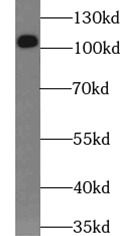Products
RBM15 antibody
| Size | Price |
|---|---|
| 100µg | Inquiry |
- SPECIFICATIONS
- FIGURES
- CONDITIONS
- FAQS
- Product Name
- RBM15 antibody
- Catalogue No.
- FNab07163
- Size
- 100μg
- Form
- liquid
- Purification
- Protein A+G purification
- Purity
- ≥95% as determined by SDS-PAGE
- Clonality
- monoclonal
- Isotype
- IgG1
- Clone ID
- 6B1
- Storage
- PBS with 0.02% sodium azide and 50% glycerol pH 7.3, -20℃ for 12 months(Avoid repeated freeze / thaw cycles.)
- Immunogen
- RNA binding motif protein 15
- Alternative Names
- RNA-binding protein 15|One-twenty two protein 1|RNA-binding motif protein 15|RBM15|OTT|OTT1 antibody
- UniProt ID
- Q96T37
- Observed MW
- 107 kDa
- Tested Applications
- ELISA, WB, IHC, IF, IP
- Recommended dilution
- WB: 1:500-1:2000; IP: 1:500-1:1000; IHC: 1:200-1:800; IF: 1:10-1:100
 HeLa cells were subjected to SDS PAGE followed by western blot with FNab07163(RBM15 antibody) at dilution of 1:1000
HeLa cells were subjected to SDS PAGE followed by western blot with FNab07163(RBM15 antibody) at dilution of 1:1000
 IP result of anti-RBM15(IP:FNab07163, 4ug; Detection:FNab07163 1:500) with HEK-293 cells lysate 2600 ug
IP result of anti-RBM15(IP:FNab07163, 4ug; Detection:FNab07163 1:500) with HEK-293 cells lysate 2600 ug
 Immunohistochemistry of paraffin-embedded human breast cancer tissue slide using FNab07163( RBM15 antibody) at dilution of 1:500
Immunohistochemistry of paraffin-embedded human breast cancer tissue slide using FNab07163( RBM15 antibody) at dilution of 1:500
 Immunofluorescent analysis of Hela cells, using FNab07163( RBM15 antibody) at 1:25 dilution and Rhodamine-labeled goat anti-mouse IgG (red).
Immunofluorescent analysis of Hela cells, using FNab07163( RBM15 antibody) at 1:25 dilution and Rhodamine-labeled goat anti-mouse IgG (red).
- Background
- May function as an mRNA export factor, stimulating export and expression of RTE-containing mRNAs which are present in many retrotransposons that require to be exported prior to splicing. High affinity binding of pre-mRNA to RBM15 may allow targeting of the mRNP to the export helicase DBP5 in a manner that is independent of splicing-mediated NXF1 deposition, resulting in export prior to splicing. May be implicated in HOX gene regulation.
How many times can antibodies be recycled?
First, usually it's not suggested to recycle antibodies. After use, buffer system of antibodies has changed. The storage condition of recycled antibodies for different customers also varies. Thus, the performance efficiency of recycled antibodies can’t be guaranteed. Besides, FineTest ever conducted the antibody recycling assay. Assay results show recycling times of different antibodies also varies. Usually, higher antibody titer allows more repeated use. Customers can determine based on experimental requirements.
Notes: After incubation, we recycle rest antibodies to centrifuge tube and store at 4℃. High titer antibodies can be stored for a minimum of one week. Reuse about three times.
What are components of FineTest antibody buffer?
Components of FineTest antibody buffer are usually PBS with proclin300 or sodium azide, BSA, 50% glycerol. Common preservative is proclin300 or sodium azide, which is widely applied in the lab and industry.
How about the storage temperature and duration of FineTest antibodies?
Most antibodies are stored at -20℃. Directly-labeled flow cytometry antibodies should be stored at 2 - 8℃. The shelf life is one year. If after sales issues for purchased antibodies appear, return or replacement is available. Usually, antibodies can be still used after the one-year warranty. We can offer technical support services.
Is dilution required for FineTest antibodies? What’s the dilute solution?
Directly-labeled flow cytometry antibodies are ready-to-use without dilution. Other antibodies are usually concentrated. Follow the dilution ratio suggested in the manual. Dilute solution for different experiments also varies. Common antibody dilution buffers are acceptable(e.g. PBST, TBST, antibody blocking buffer).
How to retrieve antibodies for immunohistochemistry?
Common retrieval buffers: Tris-EDTA Buffer(pH 9.0); Citrate Buffer(pH 6.0)
Heat induced antibody retrieval:
Method 1: Water-bath heating: Put the beaker with retrieval buffer and slide in the boiling water bath. Keep the boiling state for 15min. Naturally cool to room temperature;
Method 2: Microwave retrieval: Put the beaker with retrieval buffer and slide in the microwave oven. Heat at high power for 5min, Switch OFF for 3min, Heat at medium power for 5min. Naturally cool to room temperature.
How to choose secondary antibodies?
(1) Secondary antibodies react with primary antibodies. Thus, secondary antibodies should be against host species of primary antibodies. E.g. If the primary antibody is derived from rabbit, the relevant secondary antibody should be against rabbit. E.g. goat anti rabbit or donkey anti rabbit.
(2) Choose secondary antibody conjugates according to the experimental type, e.g. ELISA, WB, IHC etc. Common enzyme conjugated secondary antibodies are labelled by HRP, AP etc. Fluorescin or dye labelled secondary antibodies are applied in immunofluorescence and flow cytometry(e.g. FITC, Cy3).
